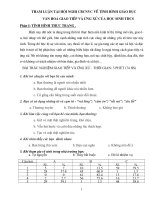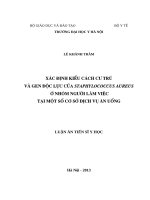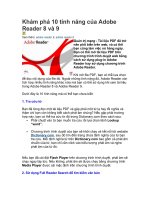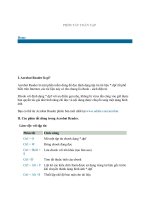ux-reader
Bạn đang xem bản rút gọn của tài liệu. Xem và tải ngay bản đầy đủ của tài liệu tại đây (4.21 MB, 181 trang )
TheUXReader
Insights on process and purpose from MailChimp’s User
Experience team
©2014MailChimp
TABLEOFCONTENTS
Introduction
Collaboration
Research
Design
Development
Refinement
Resources
Contributors
Introduction
Here at MailChimp, we like to show our work—and magical
things seem to happen when we do.
It forces us to reflect. “Let’s see. How did I do that? And why is
that the best way? Oh!”
Reflection helps us see the best parts of our process. “We saved
ourselves so much time when we built it that way.”
Sharing the best parts of our process sparks conversations.
“You did it that way? Interesting. Why?”
These conversations keep us humble. “You know, you’re right.
We probably could’ve done that differently.”
And by remaining humble and open to new ideas, we grow. “We
used to do it this way, but after some consideration and lots of
experimentation, we discovered that there’s a better way.”
We show our work, hoping to get better at what we do. This
book is the embodiment of our quest to reflect, refine, and
grow. We made it in hopes it’ll help you do the same.
But there’s another reason we made this book: It gives us an
opportunity to walk a mile in our customers’ shoes.
In 2013, we started the UX Newsletter as an excuse to use the
MailChimp app on a regular basis. It helped us see countless
things we could improve, and the refinements came fast. Now
we’re taking our little experiment further by creating and
connecting an e-commerce site to MailChimp, just like so many
of our customers have done.
Incidentally, the revenue from this book won’t land in our
pockets, but will go to RailsBridge. We love their commitment
to increasing diversity in the tech world by teaching women and
people from other underrepresented groups to code. And it’s
especially gratifying to see our efforts to improve our own work
do the same for others.
Longtime UX Newsletter readers will recognize in this book
some of our most popular articles, refined and given new life.
But this isn’t just a greatest hits collection. We’ve peppered
new content throughout, and the resources section at the end
will serve as an evergreen reference as you hone your own
practice.
Our perspective on user experience design is reflected in the
organization of the book. We start with an examination of
collaboration and teamwork. The troika of UX follows: research,
design, and development. We conclude with a selection of
articles on refinement and other processes that never really
end.
As you read, you’ll surely have questions, observations, and
feedback. In fact, we’re counting on you to get in touch and
share your perspective. Really. We’re staring at our inbox right
now.
We’re showing you our work, work that we love. If it informs
your work, even in a small way, we’ll be delighted.
Aarron Walter
Director of UX at MailChimp
COLLABORATION
BuildingaUXTeam
AarronWalter
CollaborationbyDesign
AarronWalter
AllHandsonDeck
JuneLee
AskingforHelp
FernandoGodina
OnGoodTerms
GreggBernstein
COLLABORATION
BuildingaUXTeam
AARRONWALTER
“User experience” is such a nebulous term. The UX container
can hold almost any discipline: research, design, development,
even customer support. So how do you put together an effective
team when the profiles of the members are so vastly different?
Back in 2008, when the MailChimp UX team was just me, I had
to be a generalist. I designed UIs, wrote front-end code, built
prototypes, interviewed customers, and conducted usability
tests. Working on so many different things early on helped me
see how it all fits together and shaped my views of the type of
UX team I wanted to build.
I knew I wanted to grow a team of thinkers and makers. At big
companies, UX teams often focus on wireframes and workflows
but don’t have the power to design or build the UI. Things get
lost in translation as ideas are passed to other departments. A
team filled with specialists but no generalists creates silos and
division, which lengthens iteration cycles, causes entropy and
confusion, and absolutely pollutes the user experience. I
wanted to build a team of generalists with a broad vision of the
user experience and specialists that could hone in on the
details.
Over the past 6 years, my team has grown slowly and
methodically. I brought on someone to design, then someone to
code, then someone to run usability tests, and on and on. But
they weren’t just “someones”—they were folks who could
contribute, inspire, and thrive. We’re small by design, just 12
people strong. We have 4 design researchers, 2 UI designers, 4
front-end developers, 1 expert HTML email designer/developer,
and myself. Small teams make communication easier and leave
no room for dead weight. Collaboration is easier when you know
you’re working with smart, capable people.
When I think back on how we’ve grown, I can derive a few key
lessons about building a sharp UX team. These lessons aren’t a
magic formula, but by combining a bit of rigor with a lot of
intuition, we’ve been able to get a lot done with relatively little.
Easytohire,hardtofire
Hiring is hard. It sucks up so much time, and it often feels like
you’ll never find the right person for the job. But it’s the most
important task of anyone building a team, UX or otherwise. And
that’s because it’s easy to hire someone who’s mediocre, but
it’s really hard to fire them.
Mediocre people are a drag on quality and morale, but they tend
to do just enough good work to stick around—managers have a
tough time justifying letting them go because there’s no
actionable offense. The scent of mediocrity on your team can
also scare off talented candidates. Mediocrity is an albatross we
tether ourselves to when we don’t give the hiring process our
full attention.
When you hire, look for skill fit, but don’t make it your primary
evaluation criteria. Look for passion, curiosity, selflessness,
openness, confidence, communication skills, emotional
intelligence, and intrinsic motivation, too. These things can’t
be taught—most skills can.
It sounds a bit nebulous, but I always look for the right energy
fit too. I once interviewed a candidate and knew from his
crushing handshake and deafening greeting that he would be
too overbearing for my team. As the interview proceeded, my
hunch was borne out. This guy’s alpha energy would instantly
squelch the open collaboration on my team. We spend more
time with our colleagues than we do our families. Why wouldn’t
we listen to our gut when deciding who to hire?
When building a new UX team, your instincts might draw you to
industry rock stars. Unfortunately, these folks often struggle to
collaborate and can intimidate colleagues, however
unintentionally. When hiring, ask yourself, “Can this person
say ‘we’ instead of ‘me’? Can they let someone else have the
glory? Can they put in their best work, then relinquish control
to someone else to take it further?” If yes, you’ve got a strong
candidate worth considering.
Respect
Seeing your work mistreated can be demoralizing. Researchers
throw themselves into studies that uncover insights that can
change a company, but their findings go unheeded. Designers
labor over pixel-perfect UIs, but the build-out cuts corners.
Developers write brilliant code, but the release gets spiked. You
probably have a few similar stories of your own—it’s the stuff
that resignation letters are made of.
This dynamic is bad for individuals, bad for teams, and bad for
the companies they serve. So why does it happen? Simple: A
lack of respect between peers.
Respect comes from taking time to understand one another and
our individual areas of expertise. Specialists who have mastered
their craft are ineffective if they don’t have a general
understanding of how their contributions relate to those of
their colleagues. Great designers need to understand
engineering enough to empathize with, listen to, and respond
to the people who build what they design. Great developers see
value in making an app as usable as it is powerful, and they’re
willing to go the extra mile to make the UI a little more elegant,
a little more efficient for users.
Respect fosters a can-do attitude. When colleagues value one
another, they're more open to sharing ideas, even not-so-great
ones. We could do a lot better if we started with “Yes, and...”
instead of “No.”
Respect between design and development is the most critical
ingredient in making great products, but it rarely happens
organically. It has to be a core value of a company,
demonstrated daily by leaders.
Autonomy
Even if they operate in a respectful environment, teams can
become demoralized when they have to beg for permission. It’s
hard to experiment if you have to get sign-off first, and it’s
hard to make giant leaps forward if you don’t experiment. If
failure is not an option in your organization, then neither is
success.
Teams need autonomy to make decisions quickly, to follow their
gut, to explore. Autonomy empowers people to do their best
work on tight deadlines and with limited resources. You have to
hire great people, provide vision, then get the hell out of their
way. And to do that, you have to trust each other.
Our MailChimp UX team is tiny, but our size isn’t a shortcoming
—it’s an advantage. Communication is easier when teams are
small. We’re able to make plans quickly, then get back to
making. Each little team has the autonomy to make decisions
about their own work, and when there’s uncertainty, they
discuss with another autonomous team that can provide more
definitive direction.
There’s a balance to be struck, though: Absolute autonomy can
lead to chaos. Though each team operates independently, we
never forget that we’re part of a larger organism. Our decisions
often affect the work happening elsewhere. So when big
decisions need to be made—like when we redesigned the
MailChimp app—team autonomy has to give way to the
perspective of the whole company.
Meetings are often vilified, but there’s great value in short,
regularly scheduled check-ins. Individual members of
autonomous teams need to be aware of their colleagues’
activities. A quick round-table report of what everyone’s
working on creates opportunities to collaborate and inform.
Brief chats in the hallway or by the espresso machine are also
effective at keeping people moving on a common trajectory.
These are common occurrences around the MailChimp HQ.
Parallelcycles
Lean and Agile methodologies are the religion of technology
companies trying to gain competitive advantage by iterating
quickly on their products. The problem is, fast iteration too
often happens at the expense of research. Things get done fast,
but they’re not always the right things.
The MailChimp team is agile and lean, but in lowercase. We
believe in many of the tenets of these methodologies, but we’ve
never been keen on dogma. “Move fast and fix things” pretty
much sums up our approach.
For a while we tried to tie one research workflow to the 5 week
release cycle followed by our UI design, front-end devs, and
engineering teams. That works OK when doing usability testing
to find refinement possibilities, but it greatly restricts deeper
studies. The design research team is often engaged in longterm studies about key issues that might shape company
strategy or make us rethink pieces of the app. This work
requires lots of customer interviews, surveys, ethnographic
research, and—most of all—time. The cycle for deep research is
considerably longer, and happens parallel to the rapid cycles of
app development.
Though the 2 cycles operate autonomously, the teams’ work has
to remain connected. Research that goes unapplied is of little
value. So the research team shares salient insights with
designers and developers as they find them, rather than waiting
for months to report back. And they don’t do this expecting
immediate action, just to offer context and meaning for the
work already underway.
When big studies are completed, we talk about how to fit
recommendations into our overall roadmap. Having in-depth
research continually trickling into rapid iteration cycles helps
ensure that we’re not only moving fast, but that we’re also
moving in the right direction.
Createacultureofempathy
Making new features is fun. Fixing bugs and refining workflows
is not. But to make a great product, you have to do both with
equal measures of enthusiasm.
Refinement requires motivation and, for a UX team, nothing is
more motivating than watching users struggle with your app.
From time to time we invite users to the MailChimp office to
conduct usability tests. The UX, engineering, and QA teams
watch real customers doing real work in MailChimp, and we
squirm in our seats when they struggle. The outcome of these
tests is always the same: We’re made so uncomfortable on their
behalf that we’re compelled to make things better immediately.
We also do remote usability testing, conduct customer
interviews, answer some support-related tweets, and read
thousands of account closing surveys and customer feedback
emails. The research team is largely responsible for this sort of
work, but even the front-end devs visit customers in person to
watch them use the app.
As your customers’ experiences become more visible, your team
will become more empathetic. They’ll not only be motivated to
refine, they’ll do it with speed and passion, and without being
asked.
Tellstories
When we started to fold design research into our UX practice, I
thought it was enough to collect the findings and make
recommendations. But I was wrong. Research can’t create
change in an organization until it has been turned into a
compelling story.
MailChimp has been known to write 50 page documents filled
with interesting insights about our customers and how they use
our app. It’s stuff that can help us make a better product—and
could even shape the direction of the company. But very few
people are willing to pore over giant tomes of research. It’s time
consuming, and it’s not much fun. So we thought, while we’re
on a quest to understand how to make our customers’
experience better, why not do the same for our colleagues?
We’re experimenting with creative ways to turn high-level
findings into posters, videos, and elegant web page layouts. In
these forms, our research can be grokked in seconds and shared
easily between teams. Research is much more influential when
it’s made accessible to others.
Keepgoing
I’ve been working on building and managing a UX team for
years now, and I still don’t have everything figured out. It
always seems like there’s some magic formula just around the
bend, and from what I’ve heard from UX team leaders at other
companies, I’m not the only one out here looking for it. But
maybe, just maybe, that formula doesn’t exist. There’s no one
way to describe “user experience,” so why would there be one
way to build and manage a UX team? Getting research, design,
and development to operate in harmony is what our ambiguous
craft is all about. This much I know for sure: When smart,
capable people with complementary skills are united by a deep
desire to help customers, great things happen.
COLLABORATION
CollaborationbyDesign
AARRONWALTER
A few summers ago I visited the Stanford d.school to give a
guest lecture to Enrique Allen’s d.media class. Students were
busy working on prototypes, gathering feedback, and iterating
—it was a classroom with the spirit of a startup.
During my lecture, an attentive audience sat on chairs and
couches scattered around the room. Afterwards, the seating was
rolled out to the perimeter of the room and small tables were
rolled in for collaborative conversations about student work. I
was struck by how the dynamic of the room and the behavior of
its occupants changed quickly and effortlessly along with the
furniture.
As the class wrapped up, co-instructor Scott Doorley gave me a
copy of his book Make Space, which details his methods for
creating collaborative spaces. As it turns out, the flexibility of
the classroom was no accident. Scott told me they’d been
experimenting with ideas to improve the program’s learning
experience and teach students how to think more creatively
through the design of spaces.
He took me on a tour of the school, showing me spaces for
ideation, productivity, and quiet reflection. The artifacts of
creative thinking were plastered all over the walls and scattered
throughout rooms. It was clear that ideation and collaboration
were ingrained in student work—not only through the design of
the curriculum, but also because of the design of the physical
space.
The experience changed the way I think about workspaces. And
the timing couldn’t have been better: Back home in Atlanta,
Ron Lewis, our creative director, and Mark DiCristina, our
marketing director, were hatching plans for a new, unified
design studio.
DesigningtheMailChimpstudio
Ron was already doing some research of his own, visiting
startups and design spaces in the Southeast to collect ideas that
might influence our plans. After much debate, Ron, Mark, and I
arrived at a core set of principles that shaped the design of our
studio, and in turn, how we collaborate.
1.COMMINGLEANDCROSS-POLLINATE
Because collaboration was our central motivation for creating
the new studio, we carefully considered the seating chart.
Between our teams we have design researchers, writers, graphic
designers, photographers, illustrators, developers, and
interaction designers. It’s a diverse set of skills and
personalities that make up this creative soup.
We put everyone in a wide-open space on the office's fourth
floor. Rather than segregate the teams, we mixed people up. We
looked for complementary skills and personalities, then
positioned accordingly. We put analytics people next to design
researchers, UX front-end devs next to marketing devs, and
designers next to writers. Commingling across disciplines
encourages us all to look at projects from different
perspectives. Regardless of what we each do day in and day out,
it’s all connected and equally important.
2.FACILITATEMOVEMENT
Sitting still for hours on end not only atrophies muscles, it
softens minds. So we made our workspace open and filled it
with desks, couches and standing tables to make it easy for
people to move around and collaborate, or just to get a change
of scenery.
Our open workspace also provides a landing place for smart
designers who pass through Atlanta and need a place to be
productive. James Victore, Dan Benjamin, Brad Frost, and many
more have dropped by our studio and claimed a spot for a few
hours. We love the energy and ideas guests bring to the studio
—it keeps us inspired.
3.LETIDEASHAPPENEVERYWHERE
Ron visited The Iron Yard and CoWork in Greenville, South
Carolina, and loved the Polygal walls that defined the office’s
workspaces and served as giant whiteboards. We borrowed that
idea when we built our studio. And we’ve discovered that, when
the tools are always at hand, people are more apt to draw out
their ideas together for all to see. It’s a great way to encourage
collaboration.
We combined the Polygal idea with another we discovered at
the Stanford d.school. The rolling racks you find near dressing
rooms at clothing stores can easily be retrofitted to hold a sheet
of Polygal, creating a movable whiteboard. We roll them
together to define space for creative exploration, then move
them back into place when it’s time to build out our ideas.
4.CREATECONVERGENCE
We also have a common space for lunching and chatting where
we all converge throughout the day. The heart of this space is a
fancy coffee bar where we craft caffeinated indulgences on a
LaMarzocco Linea. Great coffee draws in not only the designers,
but folks from throughout the entire company. We see
engineers, accountants, support staff, and everyone in between
pulling shots at the espresso machine, so there’s always an
opportunity to find out what other departments are up to.
Convergence points like this keep a company connected, as our
senior design researcher Gregg Bernstein wrote in his recent
article in UX Mag. All of these design choices were made to
encourage connections and conversations that lead to deeper
collaboration. They might seem like frivolous extras, but we’ve









